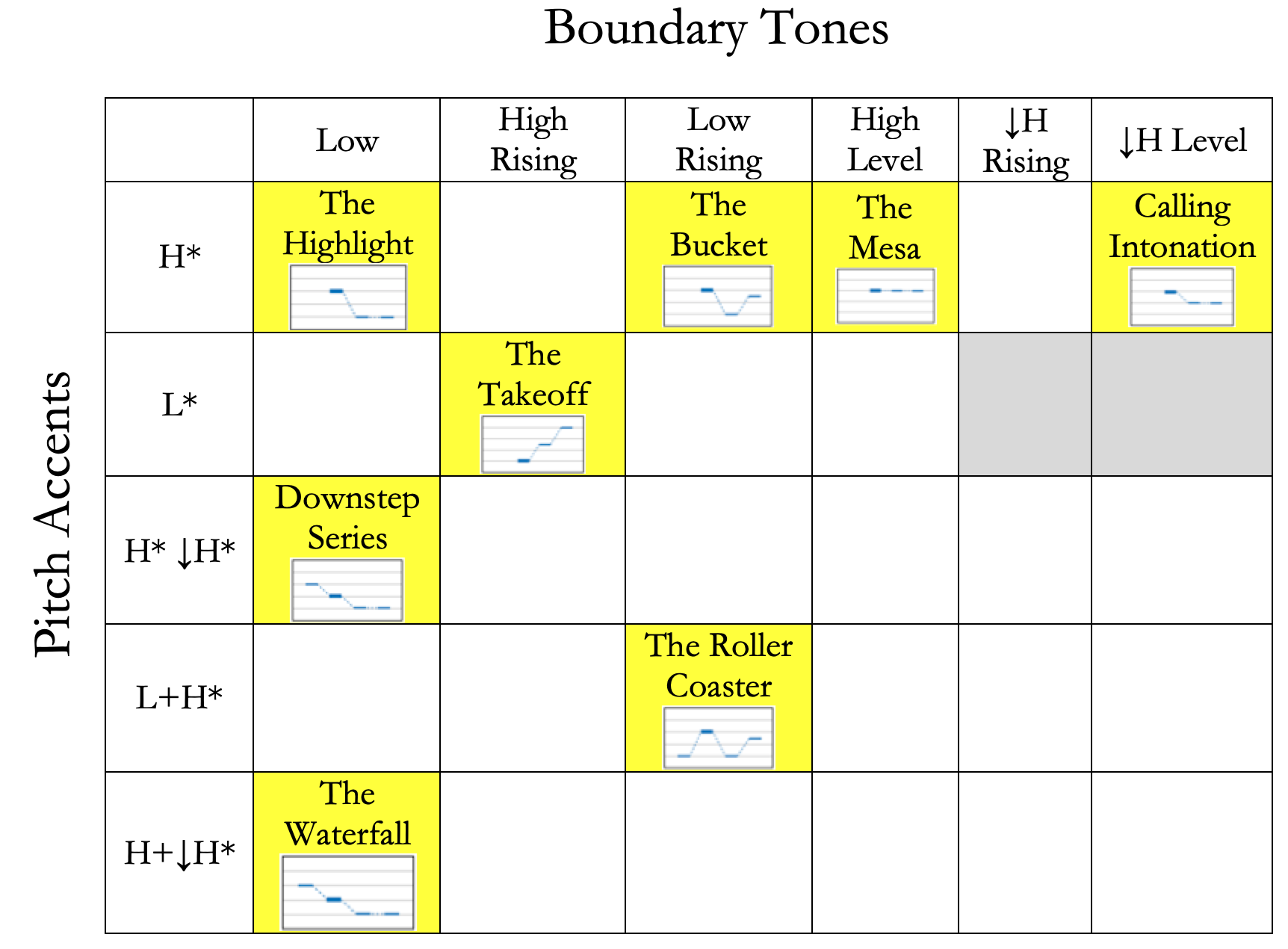Intonation in English can be broken down into 2 main aspects:
Prominences
Boundaries
Prominences: Pitch Accents
We indicate prominent syllables in three main ways: by getting louder, by lengthening them out, and by moving the pitch of our voices up or down. We call these special pitch movements pitch accents. There are five main pitch accents in American English, three relatively straightforward ones and two more complex ones.
1. High Pitch Accent
…as on the word “million” in the following audio clip:
2. Low Pitch Accent
…as on the word “another” in the following audio clip:
3. Downstepped High Pitch Accent
…as on the words “mom” and “lawyer” in the following audio clip, following after the High pitch accent on “Mallory’s”:
A Low pitch accent will always be in the lower part of a speaker’s range. A High pitch accent could be high in a speaker’s range, but it could also merely be locally high—high relative to what’s around it. The Downstepped High pitch accent, extremely common in English, is a pitch accent that is high (or locally high) in the speaker’s range, but is audibly lower than a preceding High pitch accent.
The High, Low, and Downstepped High pitch accents each consist of a single tone target. In addition to these three, there are also two “bitonal” pitch accents, in which a sequence of two tones occur within a single pitch accent. (It may be helpful to think of these as being the intonational equivalent of a diphthong.)
4. Low + High Pitch Accent
…as on the word “” in the following audio clip:
5. High + Downstepped High Pitch Accent
…as on the word “” in the following audio clip:
Notating Pitch Accents
It will be helpful to be able to notate these pitch accents. Using an asterisk symbol (*) to denote a pitch accent, we can do so as follows:
1. High: H*
2. Low: L*
3. Downstepped High: ↓H*
4. Low + High: L+H*
5. High + Downstepped High: H+↓H*
Boundaries: Boundary Tones
When we speak, we divide up our utterances into longer and shorter phrases. We do this to make meaning clear (signalling the difference between “What’s that in the road ahead?” and “What’s that in the road? A head?”, for example) to signal what information is important, and for a variety of other reasons. These units are called intonational phrases. Boundaries mark the ends of intonational phrases. We use some of the same tools to signal boundaries as we use to signal prominence: syllable length and pitch. The pitch movements associated with boundaries are called boundary tones.
There are two simple boundary tones:
1. Low
2. High Rising
A low boundary tone is nearly always falling from a previous high pitch accent (although it can be relatively flat coming from a previous low pitch accent). A high rising boundary tone continues its rise right through to the end of the intonational phrase. In American English, it is most frequently heard in yes/no questions.
There are four slightly more complex boundary tones:
3. Low Rising — as with the simple low boundary tone, this will nearly always be falling from a previous high pitch accent, but will have a slight rise at the end
4. High Level — this will usually be rising from the last pitch accent but will remain level through the end of the intonational phrase, rather than rising all the way through
5. Downstepped High Rising — the end of the intonational phrase will be marked by a downstepped high, in relation to a previous pitch accent, and then rise slightly
6. Downstepped High Level — the end of the intonational phrase will be marked by a downstepped high, in relation to a previous pitch accent, and then remain level through the end of the intonational phrase
Just as we can notate pitch accents with a * symbol, we can notate boundary tones with a right bracket: ]. We can therefore notate the six boundary tones as follows:
1. Low: L]
2. High Rising: HH]
3. Low Rising: LH]
4. High Level: Hlvl]
5. Downstepped High Rising: ↓HH]
6. Downstepped High Level: ↓Hlvl]
The Matrix
We can lay out a matrix with the five pitch accents on the y-axis and the six boundary tones on the x-axis. This yields 28 possible “tunes” (not 30 because it’s not possible for downstepped boundary tones to come after low pitch accents). Not all of these are equally common, of course. There are, in fact, four combinations that are extremely common, and four more that appear a great deal in American English. We will focus on these eight. Since they are so common, I’ve given them names to help identify and remember them.



